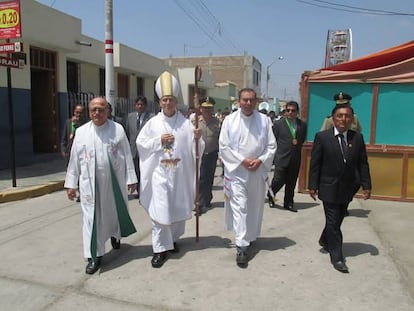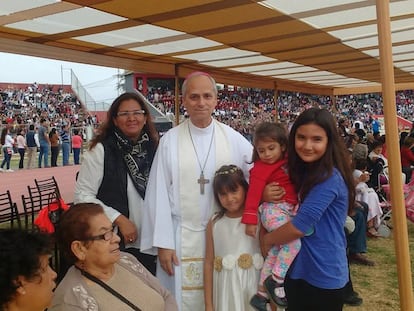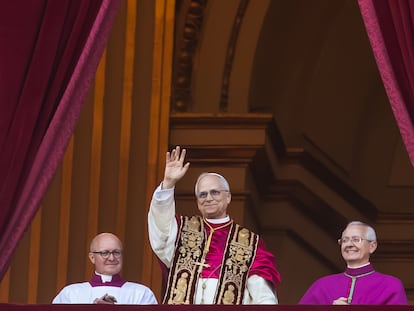Pope Leo XIV’s friend and ‘big brother’: “I think he didn’t call himself ‘Francis II’ so as not to upset the conservative cardinals”
Pedro Vásquez is one of the religious figures closest to Robert Prevost, and has even seen him cry. The two friends frequently text each other


In Chiclayo — the northern Peruvian diocese where Leo XIV was once bishop — an elderly priest is struggling to figure out how to address a pontiff on WhatsApp. And yet, he hasn’t stopped exchanging messages with Robert Prevost since he was appointed bishop in 2015.
Pedro Vásquez — an 82-year-old diocesan priest and one of the now-pontiff’s close friends — was stunned when he saw his former bishop appear on the central balcony of St. Peter’s Basilica on May 8. But he believes the signs were there. “When they made him a cardinal in 2023, I joked with him on WhatsApp: ‘It’s a sign from the Pope so you can become something else later.’ And Robert replied: ‘Don’t even think about it!’”
On a phone call with EL PAÍS from Chiclayo, Peru, he nervously vows that he’ll write to Leo XIV right away. “We stopped exchanging messages before the conclave, since he had to be incommunicado: I didn’t want to bother him. Now, I’m not sure how I should address him when I write to him again to congratulate him: Robert? Holy Father?”
The new head of the Catholic Church turned to Vásquez for spiritual advice. This is according to people who were close to the newly elected pope during his long stay in Peru.
“There was a connection between us from the very first moment,” says the retired parish priest, who considers himself to be a kind of “big brother” to Prevost (he’s 12 years older). He tells EL PAÍS that he wept “like Mary Magdalene” when he saw the red cape draped over Robert’s shoulders. And, when Vásquez saw his old friend on television, he noticed that the new Pope’s eyes had welled up behind his glasses as he looked out at the tens of thousands of faithful packed into St. Peter’s Square. But the Peruvian priest wasn’t surprised to see him crying.
“I’ve seen him cry here,” he recalls. It happened after someone “played a dirty trick” on him shortly after arriving in northern Peru. Vásquez doesn’t want to go into details about what was troubling then-Bishop Prevost, but he clarifies that it was long before he was accused of covering up abuse by priests — an accusation that was later discredited. “That didn’t make him cry — not at all. He’s gentle, but when it’s time to get serious, he shows his claws.”
According to Vásquez, Leo XIV is also “studious, intellectual, but also very practical.” And during his long stay in Peru, he was never above rolling up his sleeves. “When he finished eating, he would take his plate to the kitchen; when we were locked down during the pandemic, he would cook,” the priest explains.
Born in the United States — but also Peruvian by choice — Prevost spoke to Vásquez about his mother’s Hispanic origins. He has family roots in Ecuador and Spain. “Like Francis, his priority will be immigration,” Vásquez asserts. He doesn’t mince words on the issue. “During Trump’s first term — with his policy of separating immigrant families in 2018 — [Prevost] spoke out strongly against the U.S. president. ‘How is it possible that mothers are separated from their children?’ he asked indignantly.”
The Peruvian priest also predicts that his friend will push for changes within the Church, such as in the training of priests, a subject that has long concerned him.
“He wants seminaries to teach a theology that’s not top-down or strictly doctrinal, but one of ‘God with us.’ He’s an Augustinian, and he’ll follow Saint Augustine’s belief that the Church must always be in a process of renewal,” says Vásquez.
Why there are no female altar servers
Prevost firmly supported Pope Francis’s outreach to other religions under the now-famous motto of the Argentine pontiff: “everyone, everyone, everyone.”
And Vásquez believes that a seemingly “small” gesture from León XIV’s years in Peru may hint at his approach to women now that he is Pope. “When he arrived, he asked why altar servers in parishes had to be only boys. He opened the door to allowing girls to serve as well,” the priest recalls, lamenting that they are still the exception in the diocese today.
Jorge Bergoglio was Prevost’s mentor, and he will remain his guide. “I think he didn’t call himself ‘Francis II’ so as not to upset the conservative cardinals,” says the priest. But Pope Francis didn’t make things easy for him either. “He gave him a tough assignment when he sent him to Chiclayo. Here, the Church is polarized between those more aligned with liberation theology and more traditionalist factions. Prevost has a good touch for handling complex situations: he’s down-to-earth, but he has a firm hand.”
Father Pedro remembers him struggling through other difficult times, like the pandemic. “There was no oxygen equipment in the region. He personally managed to get two oxygen plants set up by Caritas in Chiclayo in just one week, and another one in a small rural parish.”
He did the same after Cyclone Yaku devastated northern Peru two years ago. “He put on his boots like any other farmer, trudged into the mud and personally brought aid to many affected people.”
And he dealt with a refugee crisis. “Between 50,000 and 80,000 Venezuelan migrants fleeing their country arrived in this area. They traveled the Pan-American Highway [on foot], malnourished and dehydrated. Prevost responded very quickly, giving them supplies. And, from there, a Commission on Human Mobility and Human Trafficking emerged to address some of the problems that haven’t been resolved in this region, such as [forced] prostitution and child exploitation.”
If character is destiny, this could be the future of the new Church: “He has a reserved manner, but that doesn’t mean he’s shy. He likes to talk, but he listens more than he speaks. And, when he needs to get involved, he delves deeply into the issues. He has traveled the diocese from end to end: when least expected, he would show up and surprise the parishes.”
Sign up for our weekly newsletter to get more English-language news coverage from EL PAÍS USA Edition
Tu suscripción se está usando en otro dispositivo
¿Quieres añadir otro usuario a tu suscripción?
Si continúas leyendo en este dispositivo, no se podrá leer en el otro.
FlechaTu suscripción se está usando en otro dispositivo y solo puedes acceder a EL PAÍS desde un dispositivo a la vez.
Si quieres compartir tu cuenta, cambia tu suscripción a la modalidad Premium, así podrás añadir otro usuario. Cada uno accederá con su propia cuenta de email, lo que os permitirá personalizar vuestra experiencia en EL PAÍS.
¿Tienes una suscripción de empresa? Accede aquí para contratar más cuentas.
En el caso de no saber quién está usando tu cuenta, te recomendamos cambiar tu contraseña aquí.
Si decides continuar compartiendo tu cuenta, este mensaje se mostrará en tu dispositivo y en el de la otra persona que está usando tu cuenta de forma indefinida, afectando a tu experiencia de lectura. Puedes consultar aquí los términos y condiciones de la suscripción digital.

